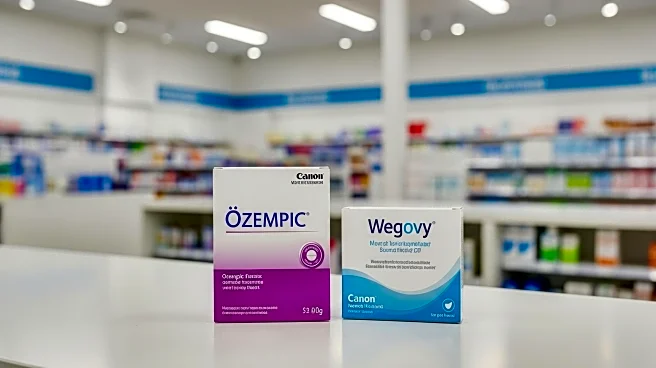What's Happening?
The emergence of GLP-1 receptor agonist drugs, such as Ozempic and Mounjaro, is reshaping consumer preferences in the food industry. These drugs, which are used for weight loss, have sparked increased interest in protein consumption due to their effects on lean muscle mass. Startups are responding by developing products that enhance protein absorption and create nutrient-dense foods. The food industry is witnessing a shift towards biomimetics, which activate GLP-1 and other appetite-regulating receptors. Experts predict that the second wave of GLP-1 drugs will drive wider adoption, prompting food companies to innovate rapidly. With over 100 clinical studies in progress, new products are expected to hit the market soon, offering solutions for weight maintenance and addressing side effects like nausea.
Why It's Important?
The impact of GLP-1 drugs on consumer behavior is significant for the U.S. food industry, as it prompts a reevaluation of product offerings and marketing strategies. As these drugs alter taste perceptions and dietary needs, food companies must adapt to meet the evolving demands of consumers. This shift presents opportunities for innovation in food formulation, particularly in creating high-protein, nutrient-dense products. The potential for a secondary market driven by GLP-1 drugs could lead to new business models and partnerships between food and pharmaceutical sectors. Additionally, the focus on personalized nutrition and gut microbiome research could revolutionize public health approaches, offering tailored dietary solutions to consumers.
What's Next?
As GLP-1 drugs continue to gain popularity, the food industry is expected to develop new products that cater to the needs of consumers using these medications. Companies may explore personalized nutrition strategies, leveraging AI and deep nutritional phenotyping to offer customized dietary solutions. The potential for 'GLP-1-friendly' branding and marketing could emerge, although regulatory considerations will play a role in defining these standards. The integration of gut microbiome research into food product development could lead to innovative approaches in appetite regulation and nutrient absorption. As the market evolves, stakeholders will need to navigate the balance between pharmaceutical advancements and food industry adaptations.
Beyond the Headlines
The rise of GLP-1 drugs highlights broader implications for the food industry, including ethical considerations around ultra-processed foods and the role of personalized nutrition in public health. The intersection of food and pharma raises questions about consumer transparency and the regulation of new product categories. As the industry adapts, there may be cultural shifts in dietary habits and perceptions of health and wellness. The focus on gut microbiome research and personalized nutrition could lead to long-term changes in how consumers approach food choices, potentially influencing societal norms around diet and health.










